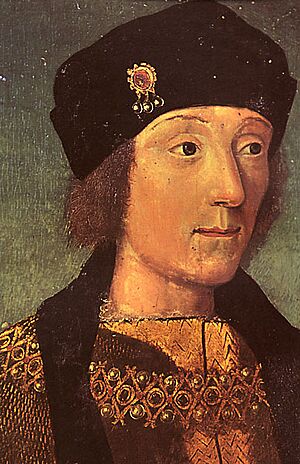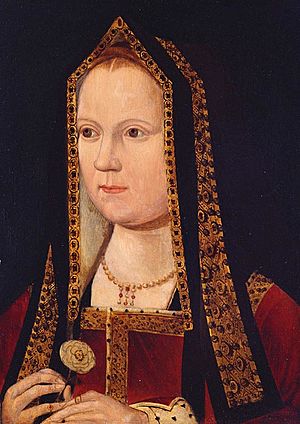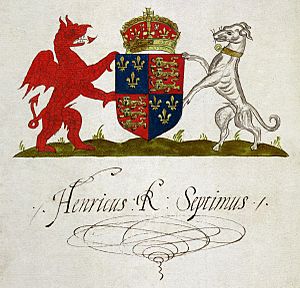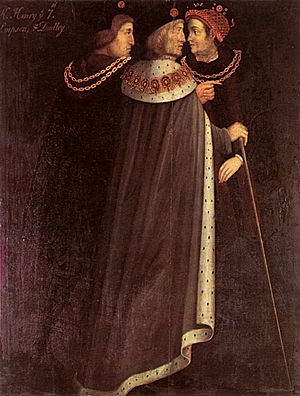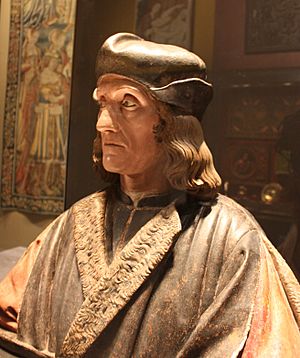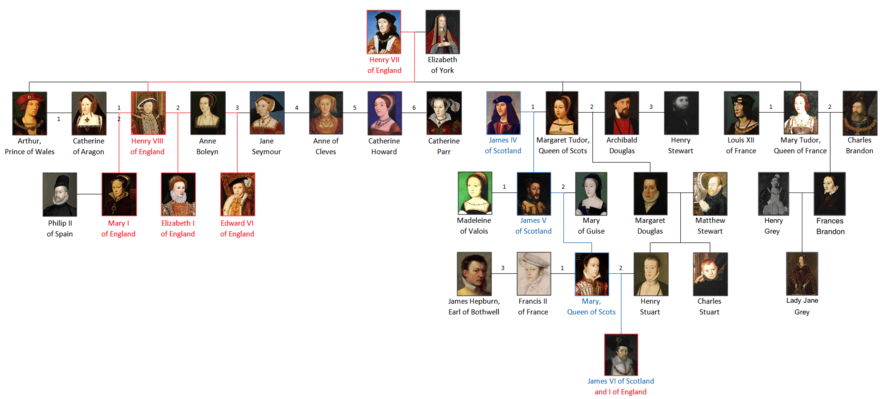Henry VII of England facts for kids
Quick facts for kids Henry VII |
|
|---|---|
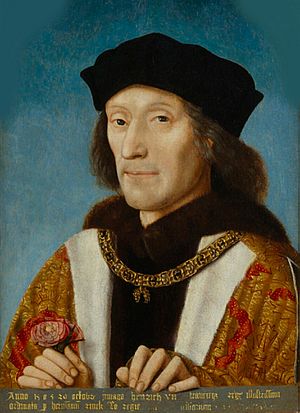
Henry holding a rose and wearing the collar of the Order of the Golden Fleece, painted by an unknown Netherlandish artist, 1505
|
|
| King of England (more...) | |
| Reign | 22 August 1485 – 21 April 1509 |
| Coronation | 30 October 1485 |
| Predecessor | Richard III |
| Successor | Henry VIII |
| Born | Henry Tudor 28 January 1457 Pembroke Castle, Pembrokeshire, Wales |
| Died | 21 April 1509 (aged 52) Richmond Palace, Surrey, England |
| Burial | 11 May 1509 Westminster Abbey, London |
| Spouse | |
| Issue more... |
|
| House | Tudor |
| Father | Edmund Tudor, 1st Earl of Richmond |
| Mother | Lady Margaret Beaufort |
| Signature |  |
Henry VII (born 28 January 1457, died 21 April 1509) was the King of England from 1485 until his death. He became king after winning a battle on 22 August 1485. Henry was the very first king from the House of Tudor, a famous royal family.
Henry's mother, Lady Margaret Beaufort, was related to the Lancaster family, one of the two main groups fighting in the Wars of the Roses. His father, Edmund Tudor, 1st Earl of Richmond, died before Henry was born. Henry spent 14 years living in exile in Brittany because the other royal family, the Yorkists, were in power. He finally became king when his army, supported by France, Scotland, and Wales, defeated King Richard III at the Battle of Bosworth Field. This battle was the last major fight in the Wars of the Roses. Henry was the last English king to win his crown on a battlefield. To make his claim to the throne even stronger, he married Elizabeth of York, who was the daughter of the previous Yorkist king, Edward IV.
Henry brought peace and stability back to England after many years of civil war. He made many important changes to how the government worked, how the economy was managed, and how England dealt with other countries. He supported England's wool industry and improved the country's finances by being very careful with money and introducing new taxes. He ruled for almost 24 years and was followed peacefully by his son, Henry VIII.
Contents
Becoming King: Henry's Early Life
Henry VII was born on 28 January 1457 at Pembroke Castle in Wales. He was the only child of Lady Margaret Beaufort and Edmund Tudor, 1st Earl of Richmond. His father passed away three months before Henry was born.
Henry's grandfather, Owen Tudor, came from a Welsh family. He worked in the court of King Henry V. Owen secretly married Henry V's widow, Catherine of Valois. One of their sons was Edmund, Henry VII's father.
Henry's mother, Margaret, was a great-granddaughter of John of Gaunt, 1st Duke of Lancaster. John of Gaunt was the fourth son of King Edward III. This family connection helped Henry claim the English throne. However, a rule made by King Henry IV said that this family line could not inherit the throne. This made Henry's claim a bit weaker. Still, by 1483, Henry was the most important male heir left from the Lancaster side of the royal family.
Henry also used his Welsh background to gain support. He came from an old Welsh family that claimed to be related to Cadwaladr, a legendary ancient British king. After his victory at Bosworth, Henry even displayed the red dragon of Cadwaladr in London.
In 1456, Henry's father, Edmund Tudor, was captured while fighting for the Lancasters against the Yorkists. He died soon after. His younger brother, Jasper Tudor, looked after Henry's mother, Margaret, who was only 13 when Henry was born. When Edward IV became King in 1461, Jasper Tudor had to leave England. Henry then lived with a Yorkist nobleman named William Herbert.
Henry stayed with the Herbert family until 1469. Then, Richard Neville, a powerful nobleman, switched to the Lancaster side. Herbert was captured and executed. When Henry VI became king again in 1470, Jasper Tudor returned and brought Henry to court. But when Edward IV took back the throne in 1471, Henry and other Lancasters had to escape to Brittany. He spent about 14 years there, protected by Francis II, Duke of Brittany.
At one point, Henry was almost handed over to English messengers. But he pretended to be sick and delayed his departure. An ally arrived with news that Francis had recovered, and Henry managed to escape to a monastery, where he found safety.
Road to the Crown: How Henry Became King
By 1483, Henry's mother was working hard to support him as a possible king instead of Richard III. Even though she was married to a Yorkist, Lord Stanley, she wanted her son to rule. On Christmas Day 1483, Henry promised to marry Elizabeth of York. She was the eldest daughter of Edward IV and was next in line to the throne after her brothers, the Princes in the Tower, disappeared.
Henry tried to invade England with money and supplies from Brittany. But his plan failed, and his main supporter, Henry Stafford, 2nd Duke of Buckingham, was executed. Henry then escaped to France, where he was welcomed and given troops and equipment for another invasion.
Henry gained the support of the Woodvilles, who were relatives of the late King Edward IV. He sailed with a small French and Scottish army and landed in Wales. Wales was a strong supporter of the Lancaster family, and Henry's Welsh background helped him gather many soldiers. He built an army of about 5,000 to 6,000 men.
Henry quickly moved to fight Richard III. Even though Henry's army was smaller, his Lancaster forces completely defeated Richard's Yorkist army at the Battle of Bosworth Field on 22 August 1485. Many of Richard's allies, like Henry Percy, 4th Earl of Northumberland, and even Lord Stanley, switched sides or left the battle. Richard III died at Bosworth Field, which officially ended the Wars of the Roses.
Henry VII's Reign: Bringing Stability to England
To make sure he stayed king, Henry declared himself king from 21 August 1485, the day before the Battle of Bosworth. This meant anyone who had fought against him was guilty of treason. He could then legally take their lands and property. Henry was crowned in Westminster Abbey on 30 October 1485. After his coronation, he promised that any nobleman who swore loyalty to him would keep their property.
Henry kept his promise to marry Elizabeth of York. Their wedding took place in 1486 at Westminster Abbey. He was 29, and she was 20. By marrying Elizabeth, Henry hoped to unite the Yorkist and Lancastrian families and end their long-standing conflicts. He was mostly successful. However, he remained very cautious of anyone with royal blood who might try to take his throne.
Henry also made a law to cancel an older rule that said Edward IV's marriage was not valid and his children were illegitimate. This made his wife, Elizabeth, a legitimate heir. Henry also worked to reduce the power of the nobles. He used special agreements to make sure they stayed loyal. He also made laws against nobles having large private armies of "retainers" or "servants."
Henry started taking steps to prevent rebellions right after the Battle of Bosworth. He sent Robert Willoughby to arrest Edward, Earl of Warwick, who was a young Yorkist heir. Warwick was taken to the Tower of London. Despite these efforts, Henry faced several rebellions.
In 1487, Yorkists supported a boy named Lambert Simnel, claiming he was Edward of Warwick. The rebellion started in Ireland, where powerful nobles declared Simnel king. However, Henry defeated this rebellion at the Battle of Stoke Field. Henry was surprisingly kind to the rebels. He pardoned the Irish nobles and even gave Simnel a job in the royal kitchen.
In 1490, a young man named Perkin Warbeck appeared, claiming to be Richard of Shrewsbury, Duke of York, one of the "Princes in the Tower." Warbeck gained support from Margaret, Duchess of Burgundy, Edward IV's sister. He tried to invade Ireland and England and even convinced James IV of Scotland to invade England. In 1497, Warbeck landed in Cornwall but was soon captured and executed.
Henry also had to deal with threats from within his own court. His own Chamberlain, William Stanley, was accused of supporting Warbeck. Stanley was arrested and executed. After this, Henry increased security around himself. In 1499, Henry had the Earl of Warwick executed.
Managing England's Money: Henry's Economic Policies
Henry VII was very good at managing money. He came to the throne with no experience in finances, but he quickly learned and made the country's treasury strong again. He kept the same financial advisors throughout his reign, which helped create stability.
Henry improved tax collection by making it very efficient. His chancellor, Archbishop John Morton, helped him with this. Morton had a clever way of making sure nobles paid more taxes: if they spent little, they must have saved a lot and could pay; if they spent a lot, they clearly had money to pay. Henry also gained wealth by taking back lands that had been given away.
However, some of his methods for collecting money were very strict and unfair. After Henry VII died, a group found out about many abuses in the tax collection process. His two most disliked tax collectors, Richard Empson and Edmund Dudley, were executed by his son, Henry VIII.
Henry VII also set a standard for weights, called the pound avoirdupois, which is still used today in some systems. In 1506, he helped restart the building of King's College Chapel, Cambridge, making sure it would be finished.
Dealing with Other Countries: Henry's Foreign Policy
Henry VII wanted to keep peace and make England rich. He mostly succeeded. He signed the Treaty of Redon in 1489 with Brittany. This treaty sent English troops to help Brittany stop France from taking it over. Henry also wanted to get back some lands in France that England had lost.
Later, Henry signed the Treaty of Etaples with France. This treaty brought money to England and made sure France would not support anyone trying to claim the English throne, like Perkin Warbeck. To pressure the French, Henry even laid siege to Boulogne in 1492. Henry also supported shipbuilding, which made the navy stronger and helped with trade. He even built Europe's first dry dock at Portsmouth in 1495.
Henry VII was one of the first European kings to see how important the newly united country of Spain was. He arranged for his son, Arthur, Prince of Wales, to marry Catherine of Aragon, a Spanish princess. He also made the Treaty of Perpetual Peace with Scotland, the first peace treaty between England and Scotland in almost 200 years. This treaty arranged for his daughter Margaret Tudor to marry King James IV of Scotland. Henry hoped this marriage would break the old alliance between Scotland and France. While it didn't happen in his lifetime, this marriage eventually led to the union of the English and Scottish crowns under Margaret's great-grandson, James VI and I.
Henry also made an alliance with Holy Roman Emperor Maximilian I. He even convinced Pope Innocent VIII to issue a special order against anyone who tried to claim his throne.
Trade and Agreements
Henry VII became very rich from trading alum, a chemical used to fix dyes in wool and cloth. Since alum was rare in Europe, it was very valuable. England's economy relied heavily on wool, so Henry got involved in the alum trade in 1486. He licensed ships, got alum from the Ottoman Empire, and sold it to other countries.
Henry's best diplomatic success for the economy was the Magnus Intercursus (meaning "great agreement") in 1496. Before this, Henry had stopped trade with the Netherlands because they supported Perkin Warbeck. This hurt both sides. The Magnus Intercursus brought trade back, which greatly benefited England by removing taxes for English merchants and increasing the country's wealth.
In 1506, Henry forced Philip the Handsome, Duke of Burgundy, to sign the Treaty of Windsor. Philip was shipwrecked in England and was pressured into an agreement that was very good for England. However, other countries rejected this treaty, and it was never fully put into action.
Keeping Law and Order: Justices of the Peace
Henry's main goal was to bring back royal authority after the Wars of the Roses. There were too many powerful noblemen who had their own private armies. Henry followed the example of Edward IV and created a Council of Wales and the Marches for his son Arthur. This council was meant to govern Wales and nearby areas.
Henry allowed loyal nobles to keep their regional power. For example, the Stanley family controlled Lancashire and Cheshire, keeping peace as long as they followed the law. In other cases, he used laws to control powerful subjects. He passed laws against nobles showing off their large groups of followers and against keeping too many "servants" who were really private soldiers. He used these laws to fine those he saw as threats.
His most important tool was the Court of Star Chamber. This was a special court made up of a small, trusted group of advisors. It could quickly deal with serious disputes involving powerful people or threats to the king's authority.
Henry VII also used justices of the peace on a large scale across the country. These officials were appointed for a year to make sure laws were followed in their areas. Their powers grew during the Tudor period, especially under Henry. Henry also made sure to control their power, using similar methods as he did with the nobles.
Justices of the peace oversaw all new laws. For example, they could replace suspicious jurors to prevent corruption. They also handled administrative tasks, like checking weights and measures. By 1509, justices of the peace were key to Henry VII's law and order. They were unpaid, which saved the king money. Local gentry saw this job as a way to gain influence and were happy to serve. This policy was very successful for Henry, making law enforcement more efficient and reducing corruption among the nobility.
Later Years and Death
In 1502, Henry VII faced a very difficult time when many people close to him died. His first son and heir, Arthur, Prince of Wales, died suddenly. This meant his second son, Henry, Duke of York, became the next in line to the throne. The King, who usually didn't show much emotion, was very sad and cried a lot when Arthur died. His concern for his wife, Queen Elizabeth, showed that they had a happy marriage. He was also heartbroken when Queen Elizabeth died the next year, shutting himself away for days.
Henry wanted to keep the alliance with Spain. So, he arranged for Prince Henry to marry his brother's widow, Catherine. This marriage would normally not be allowed by the Church, so he got special permission from Pope Julius II. Elizabeth had died during childbirth, so the permission also allowed Henry himself to marry Catherine. However, Henry later changed his mind about his son marrying Catherine. Catherine's mother, Isabella I of Castile, had died, making Catherine less important as a spouse for Henry VII's heir. The marriage did not happen during Henry VII's lifetime.
Henry thought about remarrying to have more heirs and strengthen alliances, but he never did. He considered marrying Joanna, Dowager Queen of Naples, Queen Joanna of Castile, and Margaret, Dowager Duchess of Savoy. In 1505, he sent ambassadors to Naples to check on Joanna's suitability. The wedding never happened, and the description Henry gave of his ideal wife matched his late wife Elizabeth.
After 1503, Henry VII stopped using the Tower of London as a royal home. All royal births under Henry VIII happened in other palaces. Henry VII is one of the few British monarchs known to have had no mistresses. It was also unusual for him not to remarry, especially since his son Henry was the only male heir left after his wife's death. This made the Tudor family's position very risky.
During his life, nobles often criticized Henry VII for bringing too much power back to London. Later, historians also criticized his strict tax laws. However, Henry VII was very careful with his personal money, keeping detailed records. These records show that he was a more loving father and husband than many thought. He spent generously on his wife and children, buying things like a lute for his daughter Mary and a lion for Elizabeth's animal collection.
After Elizabeth's death, Henry became very ill himself. Only his mother, Margaret Beaufort, was allowed near him. He went to a private place and refused to see anyone else. To add to his sadness, his older daughter Margaret had to leave to marry King James IV of Scotland just months after her mother's death. Henry never saw her again. Margaret wrote letters saying she was homesick, but Henry could only mourn his family and keep the peace treaty he had made.
Henry VII died of tuberculosis at Richmond Palace on 21 April 1509. He was buried in the chapel he had built in Westminster Abbey, next to his wife, Elizabeth. His second son, Henry VIII, became king and later started the Protestant Reformation in England. Henry's mother died two months after him.
Appearance and Character
Henry was known for being friendly and dignified. He was also very intelligent. Historians say he had a strong personality, could inspire trust, and was known for making smart decisions. However, he often had poor health, which made him seem a bit delicate.
Legacy and Memory
Historians often compare Henry VII to other powerful kings of his time, like Louis XI of France and Ferdinand II of Aragon. By the 1600s, historians praised Henry's wisdom in learning from other rulers. Later, in the 1900s, historians saw him as part of a "New Monarchy" trend where kings gained more power across Europe.
Family
Henry VII and Elizabeth had seven children:
- Arthur (born 19 September 1486 – died 2 April 1502), Prince of Wales and heir to the throne. He was named after the legendary King Arthur.
- Margaret (born 28 November 1489 – died 18 October 1541), became Queen of Scotland when she married James IV.
- Henry VIII (born 28 June 1491 – died 28 January 1547), Henry VII's successor as King of England.
- Elizabeth (born 2 July 1492 – died 14 September 1495).
- Mary (born 18 March 1496 – died 25 June 1533), was briefly Queen of France as the wife of Louis XII.
- Edmund (born 21 February 1499 – died 19 June 1500), was called Duke of Somerset but never officially given the title.
- Katherine (born 2 February 1503 – died 18 February 1503).
| Henry VII's position in relation to the houses of York and Lancaster (selective chart) |
|---|
| Family tree of the principal members of the house of Tudor Red text indicates Monarch of England. Blue text indicates Monarch of Scotland. |
|---|
| English royal families in the Wars of the Roses | |||||||||||||||||||||||||||||||||||||||||||||||||||||||||||||||||||||||||||||||||||||||||||||||||||||||||||||||||||||||||||||||||||||||||||||||||||||||||||||||||||||||||||||||||||||||||||||||||||||||||||||||||||||||||||||||||||||||||||||||||||||||||||||||||||||||||||||||||||||||||||||||||||||||||||||||||||||||||||||||||||||||||||||||||||||||||||||||||||||||||||||||||||||||||||||||||||||||||||||||||||||||||||||||||||||||||||||||||||||||||||||||||||||||||||||||||||||||||||||||||||||||||||||||||||||||||||||||||||||||||||||||||||||||||||||||||||||||||||||||||||||||||||||||||||||||||||||||||||||||||||||||||||||||||||||||||||||||||||||||||||||||||||||||||||||||||||||||||||||||||||||||||||||||||||||||||||||||||||||||||||||||||||||||||||||||||||||||||||||||||||||||||||||||||||||||||||||||||||||||||||||||||||||||||||||||||||||||||||||||||||||||||||||||||||||||||||||||||||||||||||||||||||||||||||||||||||||||||||||||||||||||||||||||||||||||||||||||||||||||||||||||||||||||||||||||||||||||||||||||
|---|---|---|---|---|---|---|---|---|---|---|---|---|---|---|---|---|---|---|---|---|---|---|---|---|---|---|---|---|---|---|---|---|---|---|---|---|---|---|---|---|---|---|---|---|---|---|---|---|---|---|---|---|---|---|---|---|---|---|---|---|---|---|---|---|---|---|---|---|---|---|---|---|---|---|---|---|---|---|---|---|---|---|---|---|---|---|---|---|---|---|---|---|---|---|---|---|---|---|---|---|---|---|---|---|---|---|---|---|---|---|---|---|---|---|---|---|---|---|---|---|---|---|---|---|---|---|---|---|---|---|---|---|---|---|---|---|---|---|---|---|---|---|---|---|---|---|---|---|---|---|---|---|---|---|---|---|---|---|---|---|---|---|---|---|---|---|---|---|---|---|---|---|---|---|---|---|---|---|---|---|---|---|---|---|---|---|---|---|---|---|---|---|---|---|---|---|---|---|---|---|---|---|---|---|---|---|---|---|---|---|---|---|---|---|---|---|---|---|---|---|---|---|---|---|---|---|---|---|---|---|---|---|---|---|---|---|---|---|---|---|---|---|---|---|---|---|---|---|---|---|---|---|---|---|---|---|---|---|---|---|---|---|---|---|---|---|---|---|---|---|---|---|---|---|---|---|---|---|---|---|---|---|---|---|---|---|---|---|---|---|---|---|---|---|---|---|---|---|---|---|---|---|---|---|---|---|---|---|---|---|---|---|---|---|---|---|---|---|---|---|---|---|---|---|---|---|---|---|---|---|---|---|---|---|---|---|---|---|---|---|---|---|---|---|---|---|---|---|---|---|---|---|---|---|---|---|---|---|---|---|---|---|---|---|---|---|---|---|---|---|---|---|---|---|---|---|---|---|---|---|---|---|---|---|---|---|---|---|---|---|---|---|---|---|---|---|---|---|---|---|---|---|---|---|---|---|---|---|---|---|---|---|---|---|---|---|---|---|---|---|---|---|---|---|---|---|---|---|---|---|---|---|---|---|---|---|---|---|---|---|---|---|---|---|---|---|---|---|---|---|---|---|---|---|---|---|---|---|---|---|---|---|---|---|---|---|---|---|---|---|---|---|---|---|---|---|---|---|---|---|---|---|---|---|---|---|---|---|---|---|---|---|---|---|---|---|---|---|---|---|---|---|---|---|---|---|---|---|---|---|---|---|---|---|---|---|---|---|---|---|---|---|---|---|---|---|---|---|---|---|---|---|---|---|---|---|---|---|---|---|---|---|---|---|---|---|---|---|---|---|---|---|---|---|---|---|---|---|---|---|---|---|---|---|---|---|---|---|---|---|---|---|---|---|---|---|---|---|---|---|---|---|---|---|---|---|---|---|---|---|---|---|---|---|---|---|---|---|---|---|---|---|---|---|---|---|---|---|---|---|---|---|---|---|---|---|---|---|---|---|---|---|---|---|---|---|---|---|---|---|---|---|---|---|---|---|---|---|---|---|---|---|---|---|---|---|---|---|---|---|---|---|---|---|---|---|---|---|---|---|---|---|---|---|---|---|---|---|---|---|---|---|---|---|---|---|---|---|---|---|---|---|---|---|---|---|---|---|---|---|---|---|---|---|---|---|---|---|---|---|---|---|---|---|---|---|---|---|---|---|---|---|---|---|---|---|---|---|---|---|---|---|---|---|---|---|---|---|---|---|---|---|---|---|---|---|---|---|---|---|---|---|---|---|---|---|---|---|---|---|---|---|---|---|---|---|---|---|---|---|---|---|---|---|---|---|---|---|---|---|---|---|---|---|---|---|---|---|---|---|---|---|---|---|---|---|---|---|---|---|---|---|---|---|---|---|---|---|---|---|---|---|---|---|---|---|---|---|---|---|---|---|---|---|---|---|---|---|---|---|---|---|---|---|---|---|---|---|---|---|---|---|---|---|---|---|---|---|---|---|---|---|---|---|---|---|---|---|---|---|---|---|---|---|---|---|---|---|---|---|---|---|---|---|---|---|---|---|---|---|---|---|---|---|---|---|---|---|---|---|---|---|---|---|---|---|---|---|---|---|---|---|---|---|---|---|---|---|---|---|---|---|---|---|---|---|---|---|---|---|---|---|---|---|---|---|---|---|---|---|---|---|---|---|---|---|---|---|---|---|---|---|---|---|---|---|---|---|---|---|---|---|---|---|---|---|---|---|---|---|---|---|---|---|---|---|---|---|---|---|---|---|---|---|---|---|---|---|---|---|---|---|---|---|---|---|---|---|---|---|---|---|---|---|---|---|---|---|---|---|---|---|---|---|---|---|---|---|---|
|
Individuals with red dashed borders are Lancastrians and blue dotted borders are Yorkists. Some changed sides and are represented with a solid thin purple border. Monarchs have a rounded-corner border.
|
|||||||||||||||||||||||||||||||||||||||||||||||||||||||||||||||||||||||||||||||||||||||||||||||||||||||||||||||||||||||||||||||||||||||||||||||||||||||||||||||||||||||||||||||||||||||||||||||||||||||||||||||||||||||||||||||||||||||||||||||||||||||||||||||||||||||||||||||||||||||||||||||||||||||||||||||||||||||||||||||||||||||||||||||||||||||||||||||||||||||||||||||||||||||||||||||||||||||||||||||||||||||||||||||||||||||||||||||||||||||||||||||||||||||||||||||||||||||||||||||||||||||||||||||||||||||||||||||||||||||||||||||||||||||||||||||||||||||||||||||||||||||||||||||||||||||||||||||||||||||||||||||||||||||||||||||||||||||||||||||||||||||||||||||||||||||||||||||||||||||||||||||||||||||||||||||||||||||||||||||||||||||||||||||||||||||||||||||||||||||||||||||||||||||||||||||||||||||||||||||||||||||||||||||||||||||||||||||||||||||||||||||||||||||||||||||||||||||||||||||||||||||||||||||||||||||||||||||||||||||||||||||||||||||||||||||||||||||||||||||||||||||||||||||||||||||||||||||||||||||
See also
 In Spanish: Enrique VII de Inglaterra para niños
In Spanish: Enrique VII de Inglaterra para niños
- Cestui que
- Cultural depictions of Henry VII of England



